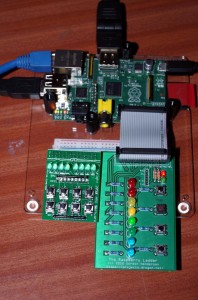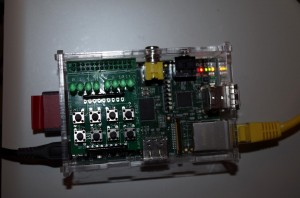John Jay based in Georgia, USA is a retired engineer who’s “gotten the PI bug” and designed some new IO boards for the Raspberry Pi. He’s currently selling them via eBay and I have some here to play with!
(I love new toys!)
So-far he’s designed a simple buttons and LED board, a stepper motor driver (although it’s really a versatile 8-bit output port with a ULN2803 darlington driver) and the third is a 32-bit GPIO extender board
The one I’m looking at today is the the buttons and LEDs board – very similar to my Ladder board, but in some ways much simpler and more down-to earth.
His boards are very small and designed to sit on-top of the Raspberry Pi. Here is the button/LED board next to my Raspberry Ladder board and on top of a Raspberry Pi:
The board plugs into the Pi (please do it while your Pi is turned off!) and there is a rubber bumper underneath to stop it wobbling and potentially shorting anything out underneath (a problem I noticed in some other boards – thankfully most people have seen the light now and are supplying these little bumpers on their boards)
The board itself presents no issues when using. John has used the switches with the long buttons which make them easier to use than the low-profiles ones. The board has the standard BCM_GPIO numbers on it – so you need to do some conversions if you are using a Rev. 2 Pi as numbers 0,1 are now 2 & 3, and 21 is now 27.
The (very bright!) LEDs have 330Ω limiting resistors and the switches connect to ground via a 1K resistor, so like my ladder board, it’s important to set the internal pull-up resistors on the Pi to read them reliably. (and the 1K resistors will prevent any damage should the pins be accidentally configured as output)
I wrote this little test program to quickly check the boards functions:
/*
* jjLed.c:
* Test program for John Jays LED and Button board
* Gordon Henderson
*
* The board is laid out as follows:
*
* LEDs: ( 8) ( 9) ( 7) (11) (10) (13) (12) (14)
*
* Switches: [16] [ 0] [ 1] [ 2]
* [ 3] [ 4] [ 5] [ 6]
*
* Numbers here are wiringPi pin numbers and will work on either
* a Rev1 or Rev2 Raspberry Pi
*
***********************************************************************
*/
#include <stdio.h>
#include <wiringPi.h>
static int leds [8] = { 8, 9, 7, 11, 10, 13, 12, 14 } ;
static int buttons [8] = { 16, 0, 1, 2, 3, 4, 5, 6 } ;
int main ()
{
int i ;
if (wiringPiSetup () < 0)
{
fprintf (stderr, "Unable to initialise wiringPi\n") ;
return 1 ;
}
for (i = 0 ; i < 8 ; ++i)
{
pinMode (leds [i], OUTPUT) ;
pinMode (buttons [i], INPUT) ;
digitalWrite (leds [i], LOW) ;
pullUpDnControl (buttons [i], PUD_UP) ;
}
for (;;)
for (i = 0 ; i < 8 ; ++i)
digitalWrite (leds [i], !digitalRead (buttons [i])) ;
}
I saved this into jjLed.c and compiled with:
gcc -Wall -ojjLed jjLed.c -lwiringPi
and run with:
sudo ./jjLed
and it worked a treat – pushing the buttons resulted in the corresponding LED being lit up while it was pushed – the top 4 buttons control the left-most 4 LEDs and the bottom 4 buttons control the right-most 4 LEDs.
John has a website which is in the process of being put together right now, (see mypishop.com) and is selling these on eBay and for $9.99 it’s not a bad deal at all and a good introduction to the Pi’s GPIO.



Hello,
Could you tell me what is the meaning of -Wall in the command:
gcc -Wall -ojjLed jjLed.c -lwiringPi
Question: No need to put a space after the -o
regards,
Sares
-Wall tells the compiler to turn on all warnings. It’s good (IMO) to get your programs to compile cleanly with this flag set – and it’ll pick up lots of potential mistakes too.
Most programs are now OK with a space after the option, so -ofile and -o file is interpreted OK.
Try:
man gcc
for more options.
-Gordon
I have posted a detailed article on assembly instructions for this kit as well as additional details on the GPIO pins mapping between REV1 / REV2 / WiringPi & Pi4J:
http://www.savagehomeautomation.com/projects/raspberry-pi-john-jays-8-led-button-breakout-board.html
Thanks Gordon for turning me on to this board!
-Robert
I still prefer my ladder board though 😉
-Gordon
Thanks for sharing with us. Your site has been a hot spot for me since I’ve had my Pi (ha). I tried to test your code above but I get an error that I thought I could surely correct. (fatal error: wiringPi.h: No such file or directory). I do have this file in (/usr/local/include/python2.7/wiringpi/) and even if I copy it to the same directory that I’m trying to build from it doesn’t work. I’m sure this is a simple fix for you but could you help to shed some light for me?
I know nothing about the Python wrappers (I didn’t do them) – all my stuff in is C…. Best to make sure you’re followed the instructions in the github site for wiringPi, but if you want the C stuff, then start here: https://projects.drogon.net/raspberry-pi/wiringpi/download-and-install/
-Gordon
Thank you! Also Thanks for all of your work with the RPi. You have helped many people including myself get a better understanding of the raspberry Pi and GPIO operations.
Gordon,
Funny you mentioned John Jay, at the beginning of your post. I was just looking at his “Protect Your Pi” board and could not figure out what the purpose of the resistor is in his kit. http://www.ebay.com/itm/251177464895?_trksid=p5197.c0.m619
You really can’t see what the resistor is connected to in the picture.
Do you want to take a stab at it?
Thanks.
I have one of those boards and am in the process of playing with it to do a wee writeup on it – just writing/testing some I2C code for wiringPi…
The resistor is connecting 3.3v to the reset pins on both chips.
-Gordon
Gordon please excuse my ignorance but would you explain the construct
for(;;) . Is it a loop statement? I am not a C programmer and I have been unable to find it in any of my reference books on C++. thanks in advance. Also thanks for the great full program listing it worked just as you wrote without any problems.
Doc
It simply means “forever”. So it will execute the next statement over and over and … until you kill the program or it encounters a break statement.
some people use while (true) or while (1), but I prefer that form.
The for loop normally takes 3 statements – the first is an initialiser, the second (middle) is a condition to test for, and the third is executed at the bottom of the loop. Any can be blank, and if there is no conditional statement, the loop loops forever.
e.g.
for (i = 0 ; i < 10 ; ++i) { printf ("%4d\n", i) ; } would read (to me) as: start i at 0, while (i < 10) ; increment i. Note that that will print 0 through 9 inclusive, but not 10. Hope that helps, -Gordon